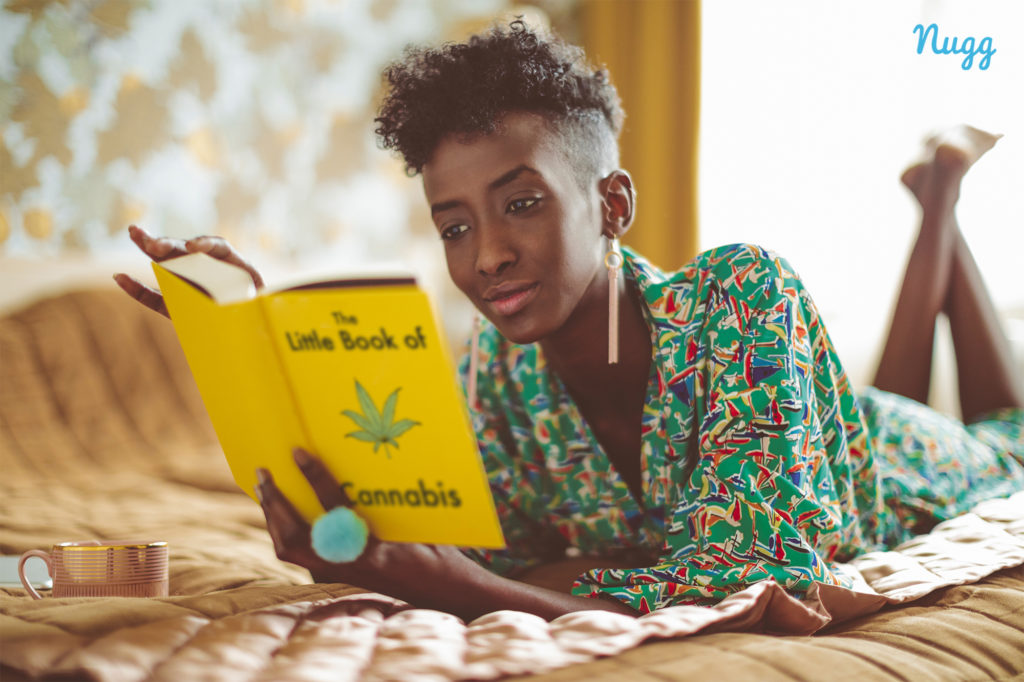Papa & Barkley 3:1 CBD:THC RELEAF Balm (2019 Review)
3 CommentsMany of my family members from an older generation are hesitant to try cannabis. It can be hard to watch, especially when they suffer from conditions I know medical marijuana could help them fight. I might not ever get them to puff on a joint, but I have convinced a few to try cannabis topical for non-intoxicating pain relief. My grandma used to experience intense arthritic pain in her hands due to inflammation; but with cannabis topical, her gnarled and cramped fingers would extend with relief and full mobility.
Perhaps my own personal experience dealing with a family member in pain makes me feel a certain kinship with the Papa & Barkley brand we’re talking about today. The brand’s name is an ode to his father and their loyal family dog, a pit bull named Barkley. The company began when a son (now the founder) wanted to help his elderly father fight immobilizing back pain. As a result, this well-respected topical brand now crafts multiple high potency formulations of cannabis topicals and tinctures to bring comfort to those that need it most. And they do it using whole plant, sun-grown cannabis from Humboldt County.
Seeing just how powerful cannabis topical can be in my own experience with elderly family members, now when I try out a new topical for my aches and pains, I think, “Would I recommend this to my grandmother?” As I try Papa & Barkley’s 3:1 (CBD: THC) RELEAF Balm, this is the high standard that I set for the product.
In this Papa & Barkley 3:1 RELEAF Balm review, you'll learn about this product's:
[Click any of the section titles below to jump there]
Packaging, Labeling and Product Design
Papa & Barkley products jump off the shelf. Not because of in-your-face packaging, but rather the complete opposite. Their understated, classy and simple packaging is unique in a world of harsh neon green and black. This Papa & Barkley 3:1 RELEAF Balm comes inside of a beautifully frosted glass jar with a honey-colored wood top, adorned with a P&B logo burnt into the wood. The P&B branded blue label is the perfect compliment to the deep green of the cannabis topical that pokes through the frosted glass. The jar is packaged safely inside of a sturdy blue box with an ink sketch of Papa himself. I could see this jar happily living on the chicest of bedside tables and bathroom countertops.
I appreciate the effort to thoroughly label this product. They include its ingredients, directions for use and some information about the Papa & Barkley brand. But there is one major aspect for concern: the printed cannabinoid contents on the front of the box (450 mg CBD: 150 mg THC) doesn’t match the lab test results label on the side of the box (374.04 mg CBD: 121.19 mg THC). If the lab testing is right (as it should be) that’s nearly 75 mg of CBD short…a major disappointment.
The label on the jar restates the 3:1 ratio and informs me this product is good for “pain and inflammation,” but doesn’t tell me much beyond that. I wish there a little more information on what conditions this product is good for. I find myself wondering, is this good for nerve pain, muscle pain, headaches, bug bites?
Luckily, there is a support phone number listed on the label that I can call to get additional answers. The helpline informs me this 3:1 RELEAF Balm is best for pain due to inflammation, like arthritis or injury. I’ve been experiencing major shoulder pain from an injury that has never quite healed, so I get ready to slather this on liberally.
Quality and Ease of Use
Since the ingredients are right on the jar, I can tell this product is high quality. No harmful fillers, chemicals or additives to be found here; just cannabis, coconut oil, beeswax, eucalyptus, tea tree, peppermint, lavender, vitamin E oil and natural terpenes. Upon opening the jar, the strong aroma of the essential blend punches my nostrils. It smells earthy yet medicinal at the same time and is honestly a bit too pungent for my tastes.
The texture of the balm inside is like that of solidified coconut oil. I scoop a generous fingerful out of the beautifully frosted jar, deposit the chunk of topical to my shoulder and, as I rub, the once-solidified coconut oil spreads like a thick liquid. This topical is so oily and doesn’t fully absorb into the skin for quite some time, so I avoid putting clothing on top of the treated area. I could see this texture being fantastic for a nice cannabis-infused massage.
This product is incredibly easy to use. Just scoop some out, rub it on and that is it! I love the large wooden top on the jar; I think even my grandmother could grab hold and open it, even with her arthritis-ridden hands.
Potency, Effectiveness and Affordability
This Papa & Barkley 3:1 RELEAF Balm works almost instantly for me. I immediately begin feeling more mobility in my shoulder and feel my body relaxing around the site of injury. It feels incredible and I find myself more grateful for the relief than I expected to be. I would be interested to see if the wonderful tingly sensation is brought on mostly by the cannabis or the strong essential oil blend. Either way, I did feel great relief! I don’t think I would use this product on more sensitive areas of the skin, for fear the essential oil blend might be too strong.
After testing three different jars of this topical, I feel very confident in its consistency. This product is highly potent, especially when compared to other cannabis topicals on the market. Because of this, the price is steep. At nearly $100 for a 50 mL jar, this topical tops the top shelf. I can’t say this high price point is always accessible for me, but if I had a more debilitating inflammation issue, I think it would be worth the investment. In the end, I would absolutely suggest this product for my grandmother.
Nugg Score: How the Nugg Team Rates This Product
Packaging: 5/5
- Balm comes packaged beautifully in a thick, frosted glass jar with a wooden lid. The lid has the P&B logo burnt into it and it’s labeled in a cool blue.
- Glass jar is housed in a sturdy cardboard box donning P&B’s classic calming blue and beige design and a sketch of the infamous Papa & Barkley.
- Unparalleled brand recognition: without being “loud,” I can spot this (and their other products) from a mile away.
Labeling: 3/5
- Printed cannabinoid contents on the front of the box (450mg CBD: 150mg THC) are contradictory to the lab test results label on the side of the box (374.04mg CBD: 121.19 mg THC).
- This contradiction is a little confusing and misleading, and the box would be much better off without printing their (what I’ll call) “targeted” cannabinoid content on the front.
- Customer support staff (whose phone number is listed on the label) is incredibly nice and willing to work through questions.
Fragrance: 3.5/5
- Blend of essential oils in this balm creates a fragrance that smells calming but medicinal. While it’s not unpleasant, it’s a little overwhelming… and lasts a long time.
- Because of the strong essential oil blend, I wouldn’t feel comfortable using this on my face or other sensitive skin areas on my body.
- Anyone with allergies to certain essential oils in this mix won’t be able to utilize the healing powers of these cannabinoids in P&B’s RELEAF Balm
Texture: 3.5/5
- Balm turns from a solid to a smooth oil as soon as it meets the heat from your body.
- While it provides a great glide for massaging it onto a sore muscle, it is pretty oily so be careful with clothing.
- Texture would be ideal for a massage.
Ease of Use: 5/5
- Product couldn’t be any easier to use.
- Lid is easy to unscrew and the mouth of the jar is wide enough to easily get to every last drop of the balm.
Ingredients: 5/5
- Simple ingredients: only cannabis, fractionated coconut oil, beeswax, a blend of essential oils (eucalyptus, tea tree, peppermint and lavender), vitamin E oil, and natural terpenes. That’s it!
- Product is completely natural, uses a whole-plant extract, it’s Cruelty-Free and Sun-Grown in Humboldt.
Effectiveness: 5/5
- I would love to see Papa & Barkley come out with a fragrance-free version of this product, not only for the reasons listed above, but also
- so I can tell if the tingling sensation is from the cannabinoids or from the eucalyptus/peppermint/tea tree oils.
- After giving my shoulder a rub with this oily balm, I immediately felt more mobility.
Consistency: 5/5
- After working with several jars of this, I always had the same experience and felt the same relief.
- If this blend of cannabinoids works for you, it should work consistently – every time.
Versatility: 4/5
- Although the customer support team assured me that it’s a great moisturizer and OK to use virtually anywhere, because of the intense essential oil mix, I’d be afraid you use this near my eyes, on any sensitive skin areas (face, lips, etc.), or skin disorders (eczema, psoriasis, etc.).
Price: 4.5/5
- At around $100 for this 50ml jar, it’s priced a bit higher than most topical cannabis products I come across, though, most cannabis topicals I’ve come across aren’t nearly as effective.
- For me, the price is a little steep because I would only use it for the occasional sore muscle. But if I had a chronic and debilitating condition, I would consider this a worthy investment.
- Because of the high cannabinoid content and potency, you may find the price to be well worth the relief it brings to your ailments.
Overall Rating: 4.35
This is one of the most effective cannabis topicals I’ve ever tried. The potent sun-grown Humboldt cannabis and proprietary essential oil blend immediately go to work to relieve pain. The beautiful Papa & Barkley packaging looks like it belongs in a high-end skincare boutique, but it’s also functional for those opening the jar with limited mobility. On the downside, the contradiction in potency labels is disappointing and the price point a bit steep. All in all, for those with chronic and debilitating inflammation, would probably find this highly potent and highly effective topical well worth the investment.
Ready to alleviate your aches and pains with Papa & Barkley’s 3:1 CBD:THC RELEAF balm? Nugg Club can deliver this product and more right to your doorstep. If you live in the LA area, click here to see if your address qualifies.
CBD: The Good, the Bad, the Astonishing
5 CommentsEver wondered if CBD is an effective medical remedy or just another snake oil? Everywhere we look we see CBD in products like vape pens, fancy waters and maple pepper chewy puppy treats. Weed carts are another popular option, offering a smooth and convenient way to enjoy the benefits of cannabis while maintaining relaxation and mental clarity. So what’s the point of taking cannabis if it won’t make you high?
Our full-service Cannabis Concierges field this question a lot, though the answer might be more surprising than you think.
What you'll learn in this article:
[Click any of the section titles below to jump there]
What Is CBD?
If you’re just joining the class, let’s review the basics. CBD, AKA cannabidiol, is considered one of the core 483 compounds contained in the cannabis plant. While it doesn’t make you high alone, it does induce a mild state of well being. Some other cannabinoids you might know are:
- THC (Tetrahydrocannabinol)
- THCA (Tetrahydrocannabinolic Acid)
- THCV (Tetrahydrocannabinol)
- CBC (Cannabichromene)
- CBN (Cannabinol)
- CBG (Cannabigerol)
- CBDV (Cannabidivarin)
Each of these distinct compounds is known for producing their own set of benefits and effects. However, cannabis is more than the sum of its separate components.
Isolates Vs. Whole Plant CBD
The cannabis compounds above are called isolates, substances that have been separated from their combined mixtures. Each isolate will have its own chemical properties and effects that are separate from the mixture they were derived from.
It’s difficult to overemphasize an important fact: these compounds can have completely different effects as isolates than they do when combined with each other.
THC alone has been proven to cause panic, anxiety and tachycardia (rapid heart rate) in some users. While this reaction isn’t fatal, it certainly interferes with the more pleasant side-effects of a high. The good news is that CBD can mitigate these negative effects.
This isn’t something to take lightly considering the plant’s medical applications. And there are more examples where this came from.
CBD More Beneficial Than THC?
Not at all. There’s an ongoing and incomprehensible myth that CBD is the good cannabinoid while THC is the bad one. Why? Probably because THC makes you high and CBD doesn’t. There’s a basic assumption behind this reasoning: things that make you feel good are bad for you. This couldn’t be more wrong.
Eating chocolate feels good; it has antioxidants, minerals and other nutrients that the body requires to maintain a healthy diet. Actually, eating anything tasty feels good. Why? The body creates reward pathways for survival so we’re more likely to do (and eat) things that are good for us.
The problem occurs when the triggering substance gets replaced with something harmful that carries the same feel-good effect. If naturally nutritious food gets replaced by processed junk, you’ll get sick—even if it feels good.
Pleasure Isn’t the Problem
Take dopamine, the chemical released with “runners’ high,” laughing, and even sex—basically anything that’s awesome. Cocaine also releases dopamine; but while the previously listed activities that lead to its release are usually healthy, cocaine is not. What’s wrong here? We’ve replaced naturally healthy methods of dopamine release with a caustic chemical that causes irritation, bleeding, and tissue damage.
The problem isn’t the reward pathway—it’s the thing that causes a reward. If it’s bad for our health, it’s a problem; if it’s good, it’s a solution. So far, THC shows promise to unlock many health benefits. Is the fact that it makes us feel good a bad thing? Of course not!
Mother Nature Knows Best
There’s another misconception that any cannabinoid works just as well without the others. This isn’t just assumed for CBD. You’ll also find potent MMJ products that have very little CBD and up to 25% THC. This isn’t necessarily the natural form of the plant that we’re evolutionarily designed to absorb.
We actually have specific receptors designed to receive cannabinoids. We create our own endocannabinoids in our cells, which bind to these same receptors. Cannabinoids are the actual substances designed for that reward pathway. Many believe the best cannabinoid combinations are those in their natural form, not distilled and purified like a pharmaceutical.
Considering the emerging evidence, there might be a case for not disturbing Mother Nature. The whole plant, with all of its complementary compounds, was designed to work together both in nature and our bodies.
The Case for Only CBD
Still, there are reasons why you might want to take pure CBD. You may:
- Want to try it for anxiety if you don’t tolerate THC well.
- Live in a state that hasn’t legalized cannabis.
- Want to test cannabis’ health benefits but get drug tested at work.
A CBD-only formula helps at least derive some benefit from cannabis, even though you can’t enjoy the full plant. Hopefully, in the future, the law won’t block anyone from enjoying the benefits of whole-plant, CBD-rich cannabis extracts.
Can CBD Convert to THC in My Body?
There’s a myth that CBD can convert to THC in our digestive systems, which is untrue. The rumor originates from a 1940s study that tested conversion rates in prolonged exposure to artificial stomach acids.
It’d take an enormous amount of CBD to end up with detectable amounts of THC in your bloodstream. Estimates are that roughly 1% to 3% of the amount of CBD ingested is converted to, and excreted out, as ∆9 and ∆8 THC.
Consider Your CBD Source
Lots of companies extract their oil from industrial hemp. It’s a little hard to believe they can extract an efficient amount of CBD from non-flowering hemp since CBD oil is mostly extracted from the cannabis plant’s resinous, flowering tops and leaves.
Other companies are going even further by extracting CBD oil from hemp seeds. While hemp seeds and hemp seed oil are wonderful sources of nutrition, they aren’t usable CBD sources as they don’t produce cannabinoids.
Another risk factor? Since so much industrial hemp is required to extract a tiny amount of CBD, contamination risk increases. If grown in a tainted area, hemp could produce polluted oil as it’s a notoriously powerful bio-accumulator. Those toxins hemp cleans from the soil have to go somewhere, and they go into the plant. So it’s better to use fewer and more resinous plants to reduce environmental toxins in the resulting oil.
What to Look for in CBD Products
The best CBD oil is produced using high-CBD plants with a high resin level, not industrial hemp. Many cultivators breed plants to be high CBD and low THC, less than .03%. These strains are proving to be a powerful treatment against Dravet’s Syndrome and other forms of epilepsy.
Just don’t forget: THC is medicine too. If you live in a legal state and work for a company that doesn’t test for THC, consider the benefits of using whole-plant, high CBD products with a complete cannabinoid profile.
Now that you know the good and bad about CBD, here are the most common ways to ingest it. Remember, always ask your doctor about the best delivery method and how much to take before medicating.
Edibles & Drinkables
There are just as many ways to eat CBD oil as there are ways to ingest THC. CBD oil is used in exactly the same way. And as the plant’s popularity continues to rise, we’re beginning to see CBDs featured at mainstream restaurants and health food stores. One of the most beautiful examples of creative consumption is the Mr. Nice Guy cocktail at San Diego’s Madison on Park.
Since you’re probably taking CBD oil for its health benefits, consider the vehicle you’re putting it in/on CBD gummies are cute and tasty, but also chock full of sugar. Instead, combine your favorite fruits with kale, chia seeds, yogurt or oats in a power smoothie and add a few drops of CBD oil to feel like a true superhero.
Potential Benefits
A CBD edible or drinkable may be a way to counteract an overactive high, since a solid dose of CBD has been shown to help calm anxiety and soothe inflammation.
And speaking of inflammation, several current studies explore the benefits of cannabinoids to soothe intestinal inflammation, Crohn’s, IBS, and other stomach related illnesses. The GI tract is lined with receptors that snatch up CBDs for these anti-inflammatory benefits. In other words, this might be the best and most effective delivery method for these conditions.
Potential Disadvantages
Make sure you have a clean source of CBD oil. As mentioned, cannabis can pull lots of toxins and pesticides from the soil. Other than this, there aren’t any know dangers; you won’t get high and you won’t overdose. Of course, read the package and make sure you’re not about to chow down on a product that contains CBD and high amounts of THC—unless you really want to.
How Much Should I Take?
It isn’t legal to list a recommended amount of CBD since the FDA reserves the right to set guidelines for nutrients. Until then, you should follow the dosage others are doing. If you are taking CBD only, typical doses are anywhere from 3mg per serving to 1,000mg per serving.
Start at a small amount, just a few milligrams, and gradually work up to the right dose for you. Everyone has different needs so most people experiment with different CBD to THC ratios and/or other cannabinoids as well.
A word of caution. If you’ve never eaten THC—even though you’ve smoked it—do not start with a high CBD/THC product. Most novices start with 5-10mg and usually feel medicated for hours. Can you imagine accidentally eating a 1,000mg brownie because you thought it was only CBD? You wouldn’t die, but it’d take a couple days to peel yourself off the walls.
It wouldn’t matter if the product had a balanced THC and CBD ratio either; no amount of CBD can counteract a dose that high. So while you freely experiment with your CBD dosage, approach any accompanying THC with extreme caution.
Sublinguals
Sometimes, under the tongue delivery is the most efficient way to take a medicine. That’s why nitroglycerin is placed under the tongue, instead of swallowed when a heart attack is near.
How does it work? The thin membrane of epithelium under the tongue is filled with large, absorbent blood vessels. When an herb absorbs into these blood vessels, it allows their compounds to pass directly into the bloodstream instead of first passing through the digestive tract.
How It’s Done
Simply place the recommended amount under your tongue and hold it there for a couple of minutes, then swallow.
Potential Benefits
Much faster delivery of its beneficial effects. If you’re using the CBDs for pain, headaches, seizures or other problems that need quick relief, many swear by this method.
Potential Disadvantages
Sometimes, you want to deliver the medicine to your digestive system first. If you are using CBD to help a rumbly tummy, intestinal distress, or liver problems, then you might be better off with an edible than sublingual delivery.
Topicals
This is a great way to take CBDs for skin problems or sore muscles. Many patients swear by CBD lotions, rubs, salves and oils for muscle pain.
How It’s Done
Just rub your CBD lotion onto your achy, itchy or splotchy parts.
Potential Benefits
Might be the best delivery method for skin conditions.
Potential Disadvantages
May not provide as potent a form of relieve as edible administration or tinctures.
A word of caution. Most say it’s impossible to absorb enough THC through your skin to fail a drug test or get high. Maybe. Most topicals just don’t have enough THC to matter. However, a tiny amount can absorb through the skin and make you high if you use enough, though it’d require more than an impractical amount.
Some theorize that many historical figures anointed themselves with cannabis oil to become high during rituals and thus commune with nature, God, etc. Likely, if they were only anointing and not smoking, they just had really soft skin.
Still, it’s better to be safe than sorry. Wait several hours and only increase the amount gradually if you’re concerned about the effects. If you choose one of those lotions with both CBD and THC (not THCA), make sure to start small and see how it affects you first. Non-decarboxylated (not heated) THCA is the precursor to THC and considered to be non-psychoactive until it’s heated.
Vaporizers
Vaping, like smoking, is one of the fastest, most potent delivery systems available. It also lasts the shortest amount of time, so the doses have to be repeated several times a day.
How It’s Done
Special cartridges of liquid cannabis extract are connected to a battery and heated until the liquid is vaporized and inhaled.
Potential Benefits
This is a convenient and unobtrusive way to inhale cannabis without the tell-tale smell. It also doesn’t expose your lungs to the tar associated with smoking dabs or flower, so some people (not all) find it to be less irritating.
Potential Disadvantages
There’s a tradeoff between vaping and smoking. Oddly, people used to consider limited smoking a healthy activity because they believed it would ward off parasites and disease. But now we realize the last thing our lungs need is a daily coating of fresh tar. So, we’ve begun to vape more often for both health benefits and the convenience.
It’s important to remember the law of unintended consequences. We haven’t been vaping long enough to understand the long-term health consequences. Additionally, many alarming safety concerns have popped up in recent months. Recently, the concentrates used in Brass Knuckles vape cartridges failed lab tests for pesticide exposure. One of the most alarming pesticides, Eagle 20, turns into cyanide when smoked—and that’s just one of the nasty pollutants they found.
If you’re vaping CBD-only cartridges for the “health benefits without the high” you could potentially be breathing in pesticides as well. Worse, some of the hemp-only CBD cartridges are sold without the same level of testing required for THC cartridges. Worst of all, many vape cartridges use propylene glycol to water down the oil into something that is easily vaped. This can irritate the lungs and there isn’t enough info about long-term consumption to ensure safety.
Yet this isn’t to say that vaping is a bad choice. It’s just a warning to consider your source carefully. Your best bet for the best benefit is to purchase fully lab-tested cartridges that don’t contain propylene glycol.
If you want to find the best CBD products, use Nugg’s cannabis delivery platform to find and have them brought to you! Unsure where to start? Consult our live chat cannabis experts who’ll help you find the best consumption method(s), dosage and lab-approved CBD products to ensure the best experience possible.
CBD Ointment Gives You Instant Pain Relief – Here’s How
13 Comments
Do you have aches and pains, but traditional creams don’t cut it, or the pills you’ve taken do more harm than good? It’s time to consider using topical CBD ointment, derived from cannabidiol, a non-psychoactive compound found in marijuana.
We have answers for you. And if one topical topic’s been on your mind more so than others, just click on that link right below!
What you'll learn in this post:
[Click any of the section titles below to jump there]
- What Is CBD Ointment?
- How Long Has Topical Cannabis Been Used?
- What Is CBD Ointment Used For?
- What's the Best Way to Apply CBD Ointment?
- CBD vs. THC: What's the Difference?
- What Makes Ointments, Creams, Salves, Balms, Oils, Lotions & Patches Different?
- How Popular Are Topicals in the U.S.?
- Do Medical Experts Support Cannabis Topicals Use?
- What Are Some Popular CBD Topical Products?
- How Can I Make Your Own CBD Ointment?
- How Can I Buy CBD Ointment & Other Topicals?
What Is CBD Ointment?
CBD ointment is a safe, easy-to-use topical agent that can be applied to almost any bodily area to relieve several problems like soreness, inflammation, and irritated skin. When applied to the skin it doesn’t create the “high” effects that cannabis ingestion does via smoking, vaporizing or eating edibles.
So CBD ointment is a great alternative for people who don’t want cannabis’ THC high and/or for those who’d like to have other options besides over-the-counter steroid-based creams.
How Long Has Topical Cannabis Been Used?
Topical cannabis use dates back thousands of years. While its primary form of ingestion has always been smoking, it’s also traditionally been used as a medicinal component to existing remedies such as ointments, salves and tinctures.
Topical use has been linked to ancient Egypt, other parts of Africa, and in Europe, where it was used for its antiseptic, antibiotic and pain-relieving properties to treat bacterial infections, skin infections, foot inflammation and localized pain.
After all, ancient civilizations relied on plant medicines for their natural therapies, and it’s really quite a shame that our modern society has departed so much from analgesic herbs. Luckily, with legalization efforts succeeding nationwide, we’re seeing substantial new interest in cannabis-derived topical therapies.
What Is CBD Ointment Used For?
CBD contains anti-inflammatory and anti-spasmodic properties, kills pain, enhances circulation and regenerates cellular activity. There are a wide variety of conditions that can be treated by using CBD ointments and other CBD infused topicals. The list is long, but a few of the most commonly treated are:
- Skin conditions: eczema, dermatitis, psoriasis, rashes, fungal infections, dry skin, blisters, etc.
- Localized joint pain, arthritis pain, inflammation muscle soreness, sprains and other mild injuries.
- Faster healing of wounds, cuts, scrapes and bruises.
- Chronic pain
- Multiple sclerosis
- Nerve pain/sciatica
- Seizures
- Muscle spasms
- Earaches
- Migraines
- Menstrual cramps
- Hemorrhoids
- Mental disorders (anxiety, depression, PTSD)
Top healing (and in some cases, now world renowned) CBD strains include:
- ACDC: a hybrid of THC and CBD considered to be the most effective for pain relief. This strain also produces relaxation and euphoria as well as a heightened focus.
- Harlequin: a sativa-based strain with a CBD and THC ratio of 5:2, Harlequin’s especially useful in treating inflammatory-based pain like arthritis or fibromyalgia. Its psychoactive properties are euphoria, increased energy and enhanced focus.
- Charlotte’s Web: with less than 0.3% of THC, this potent CBD strain produces no psychoactive effects and is best used to treat migraines, neuropathic pain, and, maybe most effectively, epilepsy.
What’s the Best Way to Apply CBD Ointment?
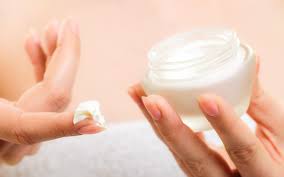
Topical CBD absorbs into the skin and is really successful when liberally applied to the affected area(s). When using topicals, be sure to first wash the area with soap and water to remove any excess dirt, oil buildup, or previously applied CBD lotions or topical creams. Doing so will ensure that there aren’t any barriers between the ointment and your skin, creating the best environment for absorption.
For adults, generously rub the ointment onto the affected area and allow it to absorb for several minutes before covering with clothing and/or bandages so it doesn’t rub off. Be sure to watch the area for bad reactions like itchiness, redness, soreness, rashes or bumps.
For children and the elderly, apply smaller amounts so they don’t over medicate since their skin is naturally thinner.
Once applied, the ointment can take anywhere from 1-48 hours to provide relief, depending on the dosage, how often it’s used, and severity of your condition.
Ointment producers typically list the recommended rate of use, which usually ranges from 1-3 times a day to as needed. Again, how often you use the ointment will depend on the severity of your condition and the product’s CBD and THC levels, so begin with doses as low as 2-3mgs then increase the amount if needed.
CBD vs. THC: What’s the Difference?
CBD appears in both cannabis and hemp, and both are widely available as ointments, but while hemp-based products contain no active THC, cannabis-derived products often do.
Seeing as how CBD and THC offer similar health benefits, patients may opt for high-CBD cannabis ointments with or without THC. But if you decide to combine CBD and THC, you’ll reap the benefits of both, from what’s known as the “entourage effect.” Research suggests that using the two together are more effective than when used individually, a fact that’s been proven with cancer research as well as with multiple ailments.
When CBD and THC are combined they produce a powerful one-two punch by enhancing each other’s most useful characteristics. Interestingly, CBD slows down the breakdown of THC in the liver, allowing THC’s therapeutic effects to last longer.
If you have plant allergies, you might want to use hemp-based CBD ointments instead of those produced from cannabis. Marijuana cultivators tend to use pesticides and other herbicides that could irritate or even worsen skin conditions for those who are particularly sensitive to these chemicals.
What’s the Difference Between Cannabis Ointments, Creams, Salves, Balms, Oils, Lotions & Patches?
Balms, creams, lotions, ointments & salves
Highly-concentrated cannabis salves and balms are great options for healing wounds and small cuts, while creams, lotions and ointments are best for alleviating itchiness, dryness, burns, rashes and other inflammatory skin conditions.
Oils
Oils tend to be higher in potency and can include THC or just CBD. They’re most likely mixed with other beneficial herbs and essential oils that penetrate the skin for deeper healing. Oils are also more versatile because they can be ingested. It’s no secret that high doses of cannabis oil have been used to effectively treat epilepsy, kill cancer cells, heal ear infections and stop migraines.
Patches
Transdermal patches containing CBD and/or THC are highly popular among pain relief seekers, as they deliver cannabinoids straight into the bloodstream for faster and more effective healing. Because they adhere to the skin they can last longer than other topicals. You can even sleep with them on and can participate in just about any activity while wearing them, whereas weed creams, marijuana salves or cannabis lotions can rub off easily.
Patches typically offer a range cannabinoids with a split 1:1 ratio of CBD to THC, but you can choose patches based on your condition and the effects you wish to receive.
Keep in mind, patches containing THC will produce a psychoactive effect that can be just as, if not more, potent than smoking, vaping or eating edibles since it’s absorbed more quickly; so CBD patches may be the best option if you need to function without those effects.
How Popular Are Topicals in the U.S.?
There are a few reasons why topical cannabis products are making their way into mainstream cannabis culture.
First, many unfamiliar patients would rather not ingest cannabis due to its psychoactive effects, and prefer to inch slowly into their cannabis experience with something milder like a tincture or topical. We totally get that, trying THC for the first time for its psychoactive effects can be intimidating (although trust us, with the proper dose, anyone can feel comfortable with it).
Next, chronic smoking could take a harmful toll on the lungs, although not enough long-term research has been done to say definitively. Some preliminary studies even show that smoking the herb could have benefits for your overall lung health, but only time will tell.
Regardless, if you want the health benefits that cannabinoids provide, topical options present a great existing alternative to other means of use.
This is especially true for aging patients, parents who use the CBD products on their children, or adults who are concerned about practical matters (like failing drug tests, for example). For these reasons, the topical medical marijuana industry is growing rapidly here in the United States, with its primary consumers being female & senior chronic pain sufferers.
That being said, when compared with the other methods of consumption, topical applications lag far behind. From our own online cannabis marketplace (think of it like the GrubHub for cannabis), topicals only make up about 1% of all purchases. Even at just 1% of total purchases, topicals saw a 100% increase in popularity since the same time last year.
Do Medical Experts Support Topical Cannabis Use?
Given the stigma surrounding marijuana and cannabinoid use in general (which is dissipating quickly), and marijuana’s Schedule I drug status with the federal government, substantial scientific and clinical research on the health benefits or consequences of cannabis have been severely constrained.
In fact, other countries like Israel are far ahead of the U.S. in attempting to decode how cannabis acts on one’s physical and psychological well-being.
That being said, preclinical evidence suggests that CBD’s therapeutic, neuroprotective, sedative and anti-inflammatory effects are very promising. Overall, the medical community agrees that CBD can provide powerful relief for many conditions and poses little to no health risk.
What Are Some of the Most Popular CBD Topical Products?
When it comes down to choosing a CBD topical, the main factors will be the CBD:THC ratio, the type of cannabinoid that should work best for your condition, and the product’s scent (although that last one usually isn’t a critical factor for many of us). Here are a few highly-rated CBD containing topicals:
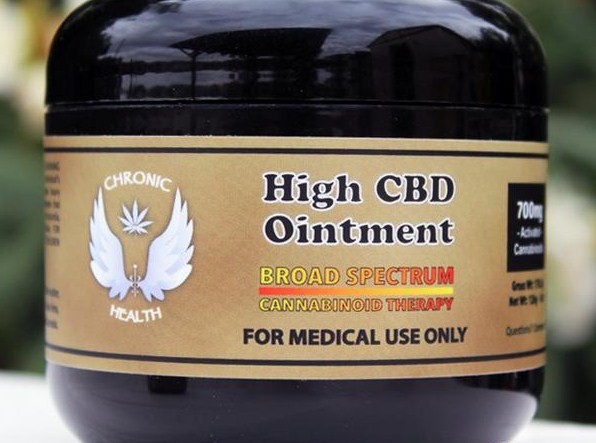
- Chronic Health (Green Halo) High CBD Ointment uses high levels of CBD in conjunction with other pain relieving cannabinoids to tackle a wide spectrum of medical conditions. Combined with almond oil, avocado oil, coconut oil, Shea butter, cocoa butter and beeswax, their CBD ointment offers a wonderful scent along with strong antibiotic and anti-inflammatory properties. Their products come in 350mg and 700mg CBD containers.
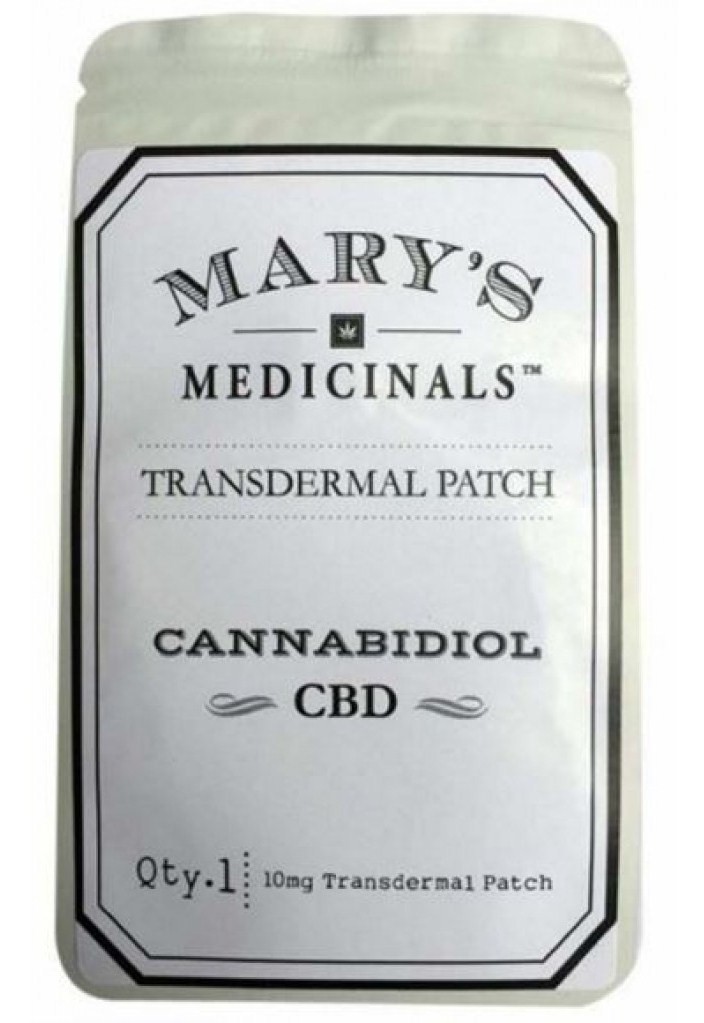
- Mary’s Medicinals has gained a lot of attention recently for their innovative CBD transdermal patches (also available in indica and sativa), childproof gel pen, topical compound that heals inflammation and back pain, and their Muscle Freeze CBD lotion that soothes and cools sore joints and muscles. Their products are discreet, simple to use, and provide strong, lasting relief. Perfect if you need constant and stable healing.
SEE ALSO: In-Depth Review of Mary’s Medicinals Products
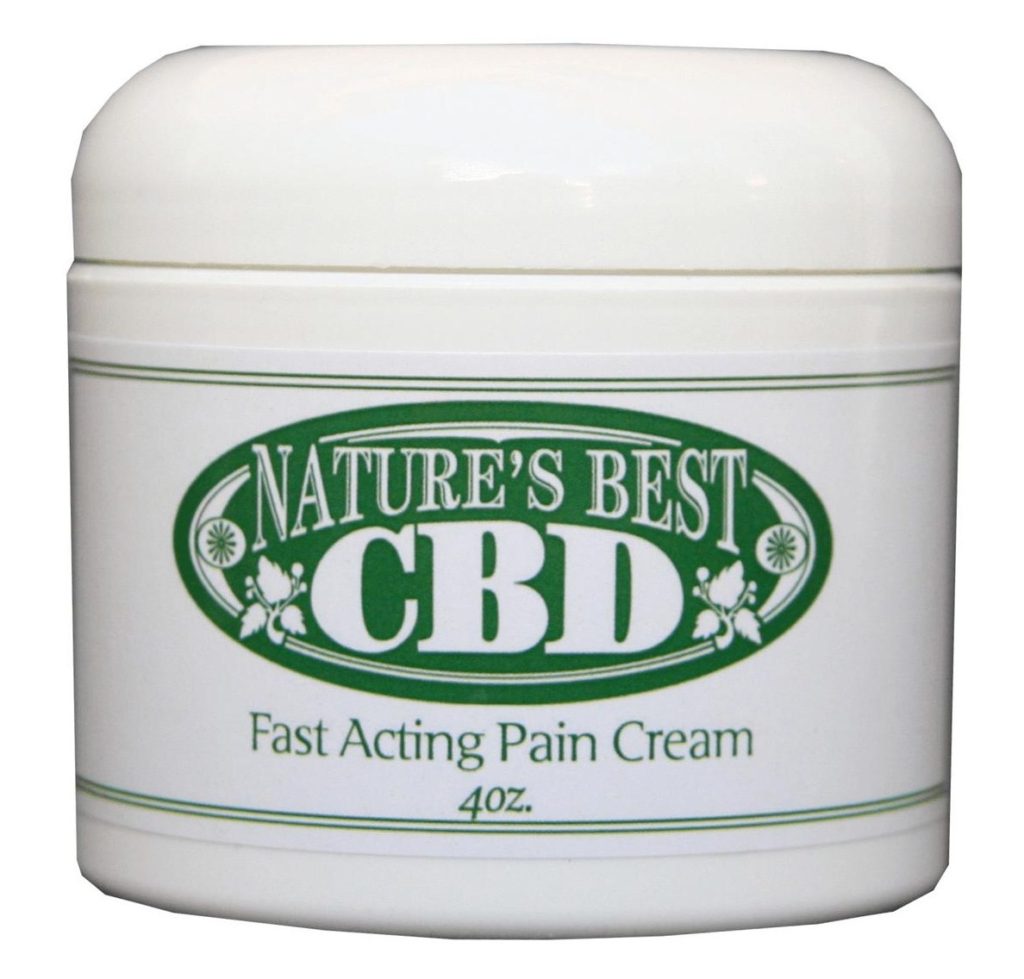
- Nature’s Best CBD is a THC-free topical designed specifically for pain relief. Created with a high absorption rate, Nature’s Best is chemically engineered to quickly penetrate the deepest layers of the skin to provide relief within minutes. Customers use it for fibromyalgia, diabetic nerve pain, eczema and a variety of other skin conditions. Keep in mind that this product also contains menthol to aid in pain relief. It’s also available in a convenient travel size 3-pack.
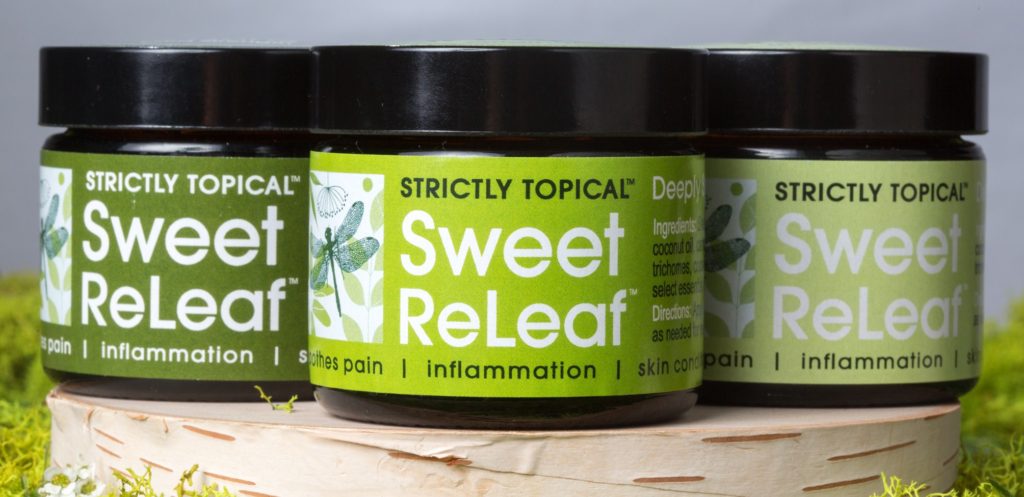
- Sweet Releaf offers a high-CBD ointment that comes scented, unscented and in extra strength formula, if needed. Their ointment is made by hand and contains, cannabis trichomes, coconut oil, Shea butter, cocoa butter and a proprietary blend of essential oils. All ingredients are organic and cruelty-free, as many believe emu oil (a common ingredient found in CBD topicals) to be extracted in inhumane ways. Users have found that Sweet Releaf reduces inflammation, swelling, muscle, back and joint pain, spasms and more.
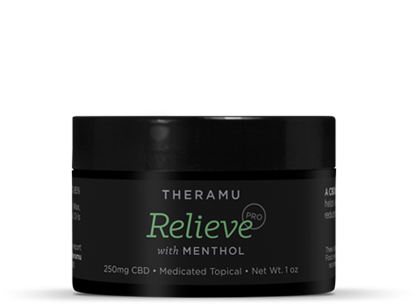
- Theramu Relieve is a fast-acting compound that combines 100mg of pure hemp extract and emu oil (a carrier of CBD) for deeper penetration. Theramu boasts no side effects nor interference with other medications, and that’s only possible because hemp extract is not the same as cannabis-derived CBD. In fact, hemp-derived CBD is available in only trace amounts and does not provide the same wide-ranging medical benefits that true CBD products will. Nonetheless, it can still be a useful anti-inflammatory and wound healer, but should be considered more along the lines of a dietary supplement as opposed to true medicine.
How Can I Make My Own CBD Ointment?
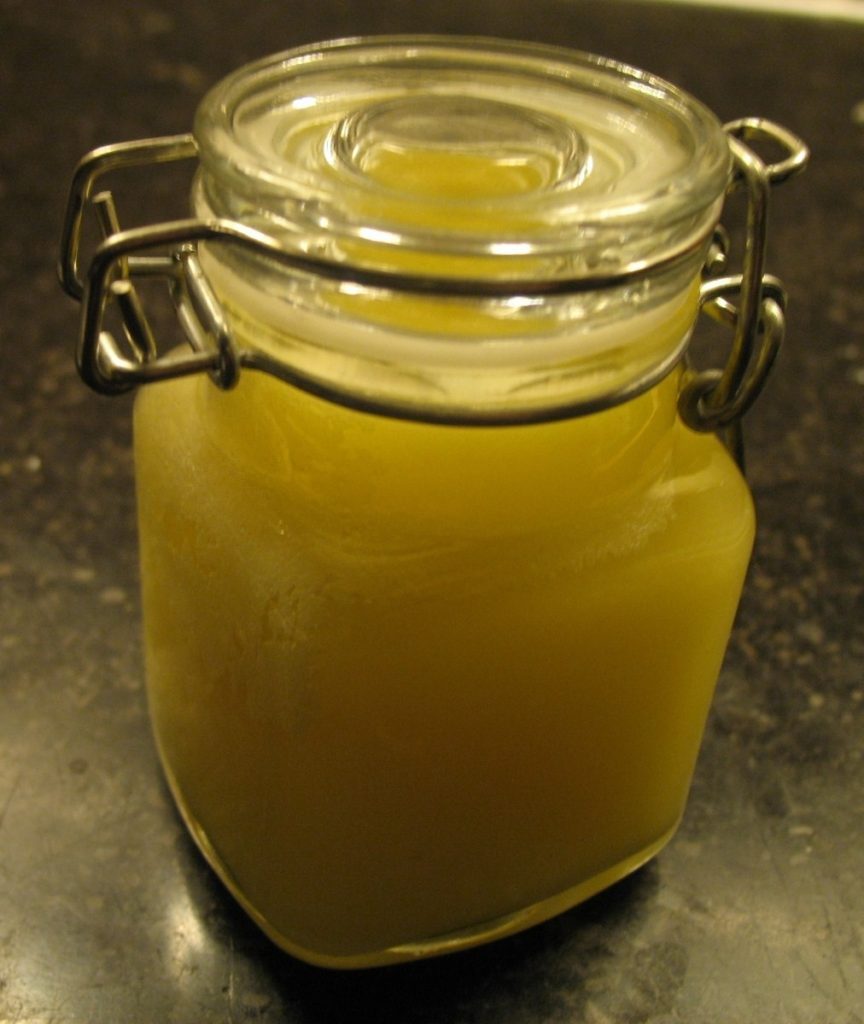
If you’d like to create your own ointment, here’s a CBD ointment recipe to make at home:
- Gather at least 10 grams of organic hemp for a CBD only ointment, or combine it with ½ oz of herbal cannabis for a combined CBD-THC effect.
- Grind all leaves and stems with a coffee grinder, then place them into a jar.
- Pour an organic, preferably extra virgin carrier oil like coconut or almond, over the hemp/cannabis. The ground hemp/cannabis should be completely covered in oil.
- Seal the jar tightly, fill a saucepan with 2-3 inches of water, then place the jar into the pan. Bring to a low boil for 3 hours. Be sure to refill the pan when the water level gets too low.
- After 3 hours, remove the jar from the saucepan and allow it to cool at room temperature.
- Repeat the low boiling process over the next 2 days for another 3 hours each day; this will increase the ointment’s potency.
- On the 4th day, use a cheesecloth to strain the ointment into a new jar to remove the excess debris.
- Add beeswax, cocoa butter or Shea butter to thicken and firm up your ointment. Now it’s ready to use!
- Store in a cool, dry place otherwise the ointment’s consistency can change dramatically.
How Can I Buy CBD Ointment & Other Topicals?
Not in the mood to make your own CBD ointment? Rather leave ointment making to the professionals, you’re in luck! Finding some high-quality CBD cannabis ointment takes just a few clicks on getnugg.com.
Nugg provides safe and legal access to the relief you require. Simply enter your zip code and gain instant access to several vetted cannabis dispensaries near you. Nugg also provides customer-rated storefront collectives and delivery options for CBD ointments along with a plethora of cannabis topicals to be delivered straight to your doorstep!
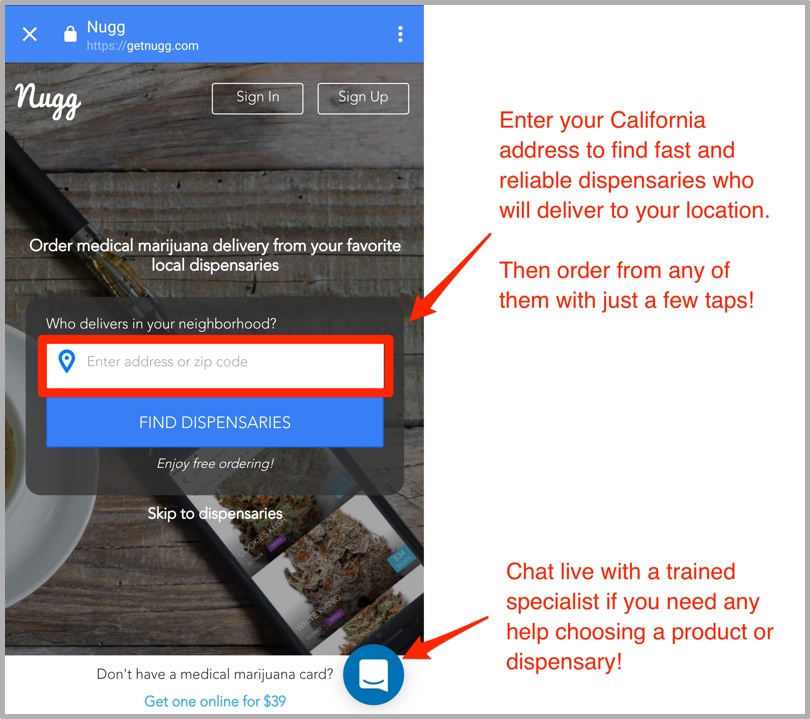
Though many online retailers will claim they can ship products containing CBD your way since CBD is legal to use, keep in mind that shipping these CBD products is actually illegal. A medical marijuana recommendation or card must be presented to purchase CBD products within the state of California and everywhere else.
If you’re in need of a medical marijuana card, just visit NuggMD to get yours in minutes. There’s no appointment needed, and you won’t be charged the small $49 fee unless your doctor approves!

